Cucumbers reign supreme for vinegar pickling thanks to their perfect crunch, but don't limit yourself to just this classic choice. You'll get fantastic results with crisp green beans, naturally sweet baby carrots, and versatile onions that enhance countless dishes. Root vegetables like beets and turnips offer complex flavors and impressive nutritional benefits, while asparagus and okra maintain their satisfying texture through the pickling process. For heat lovers, jalapeños and radishes add exciting kick to your pickle collection. Each vegetable brings its own unique charm and health benefits to the pickling party – and there's so much more to explore.
Why Vinegar Pickles Matter
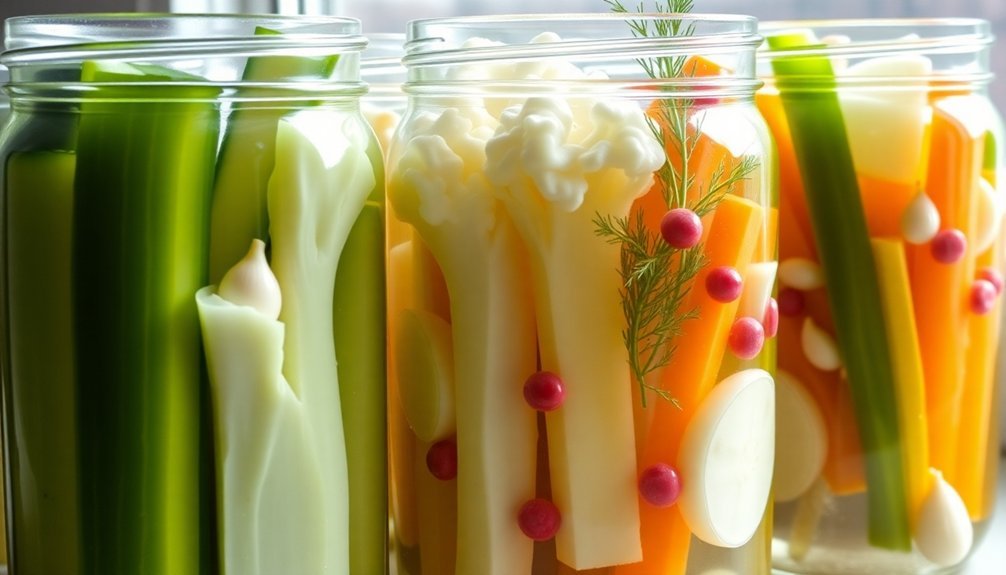
Why have vinegar pickles remained a beloved food staple across cultures for thousands of years? Beyond their distinctive taste and satisfying crunch, vinegar pickles offer remarkable health benefits that you'll want to reflect on adding to your diet.
You're getting a powerful boost to your gut health when you eat fermented pickles, as they're packed with probiotics that maintain a healthy bacterial balance and improve your digestion. For optimal benefits, choose kosher dill pickles rather than heat-processed varieties.
If you're watching your weight, you'll appreciate that pickles are virtually calorie-free while helping you feel fuller longer. The acetic acid from vinegar reduces your appetite and slows down carbohydrate absorption, making it easier to manage your weight.
What's more, you'll find that vinegar pickles can help control your blood sugar levels, especially if you have Type 2 diabetes.
The antioxidants in pickles, including beta-carotene and flavonoids, protect your cells from damage and reduce your risk of chronic diseases.
You're also getting essential nutrients like vitamin K, vitamin C, and potassium with every bite.
These benefits explain why pickles aren't just a tasty addition to your meals – they're a smart choice for your overall health.
Essential Vegetables for Pickling
You'll find cucumbers leading the pack of classic pickling vegetables, but there's so much more to explore beyond this traditional favorite.
From colorful bell peppers and beets to flavor-packed hot peppers and garlic scapes, your pickling options are remarkably diverse. Green beans and carrots provide excellent crunch and maintain their texture beautifully during the pickling process.
Whether you're seeking crunch, color, or bold flavors, vegetables like asparagus, cauliflower, and even rainbow chard stems can transform your pickling projects into unique culinary creations.
Classic Pickling Power Players
While countless vegetables can be pickled, certain classics have stood the test of time for their exceptional pickling qualities. Cucumbers remain the undisputed champion, consistently delivering the perfect crunch and absorbing flavors beautifully in the pickling brine. You'll find them in nearly every cuisine worldwide, proving their universal appeal. Quick pickles last several months when stored properly in the refrigerator.
Green beans and carrots stand out as reliable pickling candidates you shouldn't overlook. Green beans maintain their crispy texture throughout the pickling process, making them ideal for salads and snacking. Baby carrots not only add vibrant color to your pickled creations but also contribute a natural sweetness that balances the tanginess of vinegar.
Don't forget about onions and beets, two powerhouse vegetables that transform magnificently when pickled. Onions become wonderfully versatile additions to sandwiches, seafood dishes, and salads, while beets introduce a sweet-tangy profile that's particularly celebrated in Middle Eastern cuisine.
You'll often find beets paired with turnips, creating a dynamic duo that offers both flavor complexity and nutritional benefits. These vegetables retain their distinctive characteristics while taking on the delicious tanginess of your pickling brine.
Beyond Traditional Pickle Choices
Moving beyond traditional cucumber pickles opens up an exciting world of unique textures and flavors. You'll discover that vegetables like asparagus and okra retain their satisfying crunch while absorbing tangy brine, making them perfect for sandwiches, salads, and standalone snacks.
Cauliflower and turnips offer healthy alternatives that maintain their snap while providing essential nutrients and fiber.
When you're looking to add bold flavors, consider pickling jalapeños with honey and cumin, or transform garlic into a sweeter, milder version of itself that's perfect for pasta dishes and bread.
Pickled onions and peppers will elevate your sandwiches and nachos, while beets can be paired with turnips for a striking pink hue and complex taste profile.
For maximum versatility, try pickling green beans with garlic or carrots with ginger. These combinations work wonderfully in salads or as side dishes.
You'll find that radishes bring a spicy crunch to barbecue spreads, while okra can replace traditional pickles in burgers.
Each vegetable offers its own unique benefits, from turnips' low-calorie profile to garlic's health-boosting properties, making them smart additions to your pickling repertoire.
Health Benefits of Pickled Vegetables
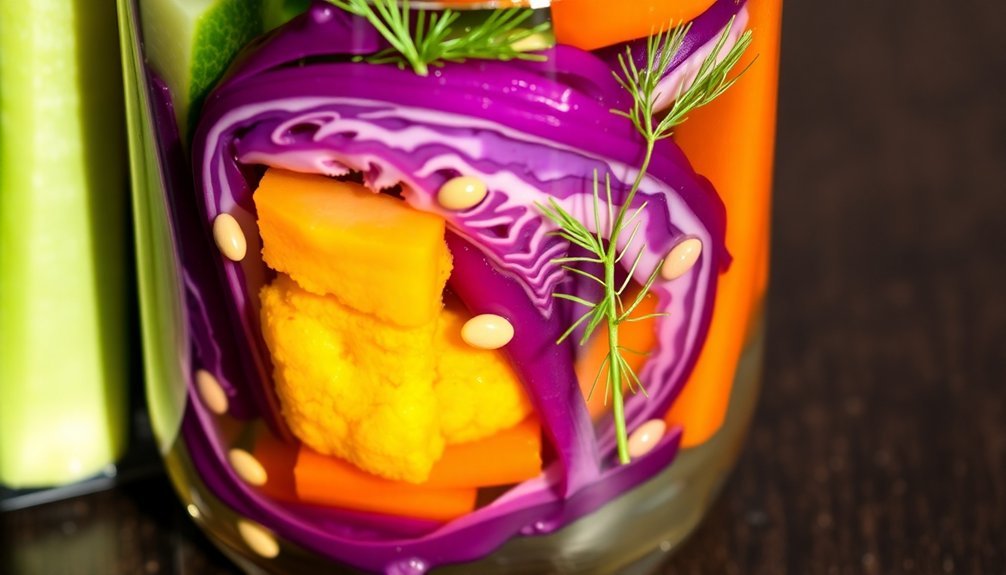
The preservation of nutrients during pickling makes these vegetables a powerhouse of health benefits. You'll retain most of the original fiber, vitamins, and minerals, while fat-soluble vitamins can become even more concentrated.
Though some water-soluble vitamins like vitamin C may decrease, you'll gain higher amounts of certain B vitamins through the fermentation process.
When you eat pickled vegetables, you're introducing beneficial bacteria like Lactobacillus into your digestive system. These probiotics support your gut microbiome, enhancing immune function and contributing to better mental well-being.
They're also valuable allies in maintaining healthy digestion and metabolism.
You'll benefit from powerful antioxidants, including flavonoids and phenols, that fight inflammation and oxidative stress. The fermentation process creates alkyl catechols, which help protect you against chronic diseases and boost your body's natural defense mechanisms.
However, you'll want to be mindful of sodium content, especially in store-bought varieties. If you're watching your salt intake, consider making pickles at home where you can control the amount of salt and sugar.
This way, you'll maximize the health benefits while minimizing potential drawbacks.
Quick Pickling Made Simple
Quick pickling's simplicity makes it an ideal starting point for home preservation enthusiasts. You'll find the process straightforward: start by washing and cutting your vegetables to your preferred size, keeping in mind that thinner slices pickle faster.
Mix equal parts water and vinegar to create your brine, then dissolve sugar and salt by heating the mixture. You can choose from various vinegars – apple cider, distilled white, red wine, white wine, or rice wine – to achieve different flavor profiles.
For crisp pickles, especially cucumbers, let the brine cool before pouring it over your vegetables. Remember to leave about an inch of headspace at the top of each jar.
You're not limited to single-vegetable pickles; feel free to combine different vegetables in one jar. Whether you're using garden surplus or store-bought produce, you'll want to guarantee your vegetables are fresh and crisp.
Once you've added the brine, let your pickles marinate for at least an hour. After cooling to room temperature, transfer them to the refrigerator, where they'll keep for 2-3 weeks.
You'll find these quick pickles perfect for enhancing tacos, salads, sandwiches, and charcuterie boards.
Herbs and Spices Combinations
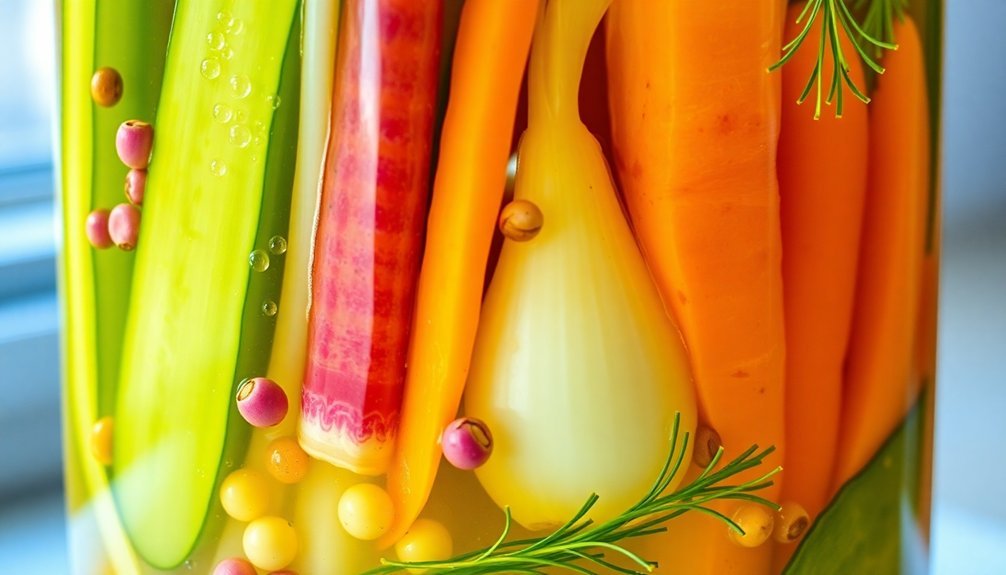
Selecting the right combination of herbs and spices transforms ordinary pickled vegetables into vibrant, flavorful preserves. You'll want to start with whole spices like coriander and mustard seeds as your base, then layer in complementary flavors that enhance your chosen vegetables.
For classic dill pickles, combine fresh dill with garlic, black peppercorns, and mustard seeds. If you're pickling carrots, try pairing fresh ginger with coriander seeds and a touch of citrus peel for brightness.
When working with spicier vegetables like jalapenos, blend cilantro with garlic and cumin seeds for a Mexican-inspired profile. Don't forget to evaluate heat levels in your combinations. You can adjust the spiciness by adding chili peppers or red pepper flakes, or keep things mild by focusing on aromatic herbs like tarragon or basil.
For an Asian-inspired pickle, combine star anise with ginger and citrus peel. When pickling beets or turnips, try juniper berries with black peppercorns and fresh horseradish for an earthy, complex flavor.
Remember that whole spices maintain their flavor better during the pickling process than ground versions.
Best Vinegars for Pickling
With your spice combinations ready to go, choosing the right vinegar will make or break your pickling project.
You'll find distilled white vinegar is the most versatile option, offering a neutral base that won't compete with your seasonings while maintaining the natural colors of your produce.
If you're looking for something with more character, apple cider vinegar adds a mild, fruity undertone to your pickles. While it may slightly tint lighter vegetables, it's an excellent choice for robust produce.
Wine vinegars, whether from regular wine, champagne, or sherry, bring subtle complexity to your pickles and work particularly well with cabbage and bold vegetables.
You'll want to avoid using rice vinegar for canning, as its acidity level typically falls below the required 5% for safe preservation.
While balsamic vinegar offers intense flavor, it's best used as part of a vinegar blend rather than on its own.
For traditional British-style pickles, especially beetroot, malt vinegar delivers a deep, distinctive taste.
Remember that whichever vinegar you choose, it must have at least 5% acidity to guarantee safe preservation through the canning process.
Creative Ways to Serve
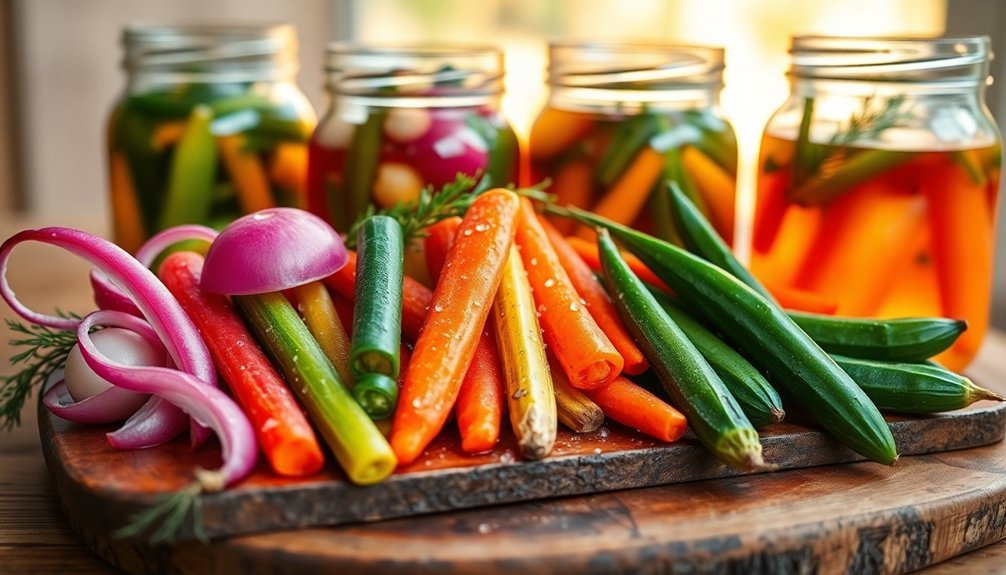
You'll find pickles are perfect party starters, whether arranged on charcuterie boards with cheese and crackers or mixed into deviled egg filling for crowd-pleasing appetizers.
For everyday meals, think beyond basic sandwich toppings and try adding pickled vegetables to spring rolls, omelets, or fried rice for unexpected bursts of flavor.
Your homemade pickles can transform ordinary dishes into standout creations, from topping pizzas with pickled garlic scapes to garnishing soups with colorful pickled vegetables.
Appetizer Party Ready Pairings
From casual gatherings to formal soirées, pickled vegetables create endless possibilities for creative appetizer pairings. You'll dazzle your guests by incorporating pickled elements into classic deviled eggs, where finely chopped pickles and a splash of brine transform the traditional filling into a tangy masterpiece.
Your charcuterie boards will shine when you strategically place pickled carrots, radishes, and garlic alongside rich cheeses and cured meats. The acidic crunch perfectly balances creamy and salty components while adding visual appeal to your spread.
| Appetizer | Pickle Pairing | Flavor Impact |
|---|---|---|
| Deviled Eggs | Chopped Dill Pickles | Tangy & Creamy |
| Charcuterie | Pickled Carrots | Sharp & Sweet |
| Bloody Mary | Pickled Asparagus | Spicy & Savory |
| Spring Rolls | Pickled Radish | Crisp & Zesty |
Don't forget to elevate your cocktail game by using pickled garnishes in drinks like Bloody Marys or pickle-infused vodka creations. For a unique dip experience, try topping classic hummus with finely diced pickled vegetables or blend pickle juice into your favorite salsa recipe for an unexpected twist.
Beyond Basic Sandwich Toppings
Pickled vegetables deserve more recognition beyond their classic role as sandwich toppers. You'll find countless creative ways to incorporate these tangy treats into your everyday meals, from hearty mains to playful appetizers.
Transform your favorite comfort foods by adding pickled elements. Try stuffing your burger patties with chopped pickles and cheese for a surprising burst of flavor, or brine your chicken in pickle juice before frying for exceptionally moist and flavorful results.
For a unique pizza experience, top your pie with dill pickles and crispy bacon.
Elevate your salads by incorporating pickled vegetables in unexpected ways. Toss chopped pickles into pasta salad with shredded cheese and fresh vegetables, or create a zesty potato salad with diced pickles and traditional ingredients.
For a lighter option, mix pickled radishes, carrots, or cherry tomatoes with fresh greens.
Don't forget about hot dishes. Add depth to your soups with pickle-based broths, or garnish them with homemade pickled vegetables.
For breakfast, liven up your omelets with diced pickled vegetables, creating a savory morning meal with an extra punch of flavor.
Storage and Shelf Life
Proper storage methods can make the difference between pickles that last for months and those that spoil quickly. If you're using full-strength vinegar (5% acidity), you can store your pickles at room temperature without canning, provided they're completely submerged in the vinegar solution and stored in nonreactive containers.
For long-term storage, properly canned pickles will last up to a year in a cool, dark place. Once you've sealed your jars, remove the rings and label them with contents and dates. You'll need to refrigerate them after opening.
| Storage Type | Shelf Life | Special Requirements |
|---|---|---|
| Full-Strength | 3-4 months | 5% vinegar, complete submersion |
| Canned | Up to 1 year | Proper sealing, cool storage |
| Fermented | 2-3 months | Constant refrigeration |
| Refrigerator | 3 months | Immediate refrigeration |
If you're making fermented pickles, they'll need constant refrigeration to maintain their probiotic benefits and crispness. Keep them submerged using glass weights and sealed with nonreactive lids. For all pickle types, verify your containers are thoroughly cleaned and dried before use, and always check for signs of spoilage before consuming.
Beyond Traditional Cucumber Pickles
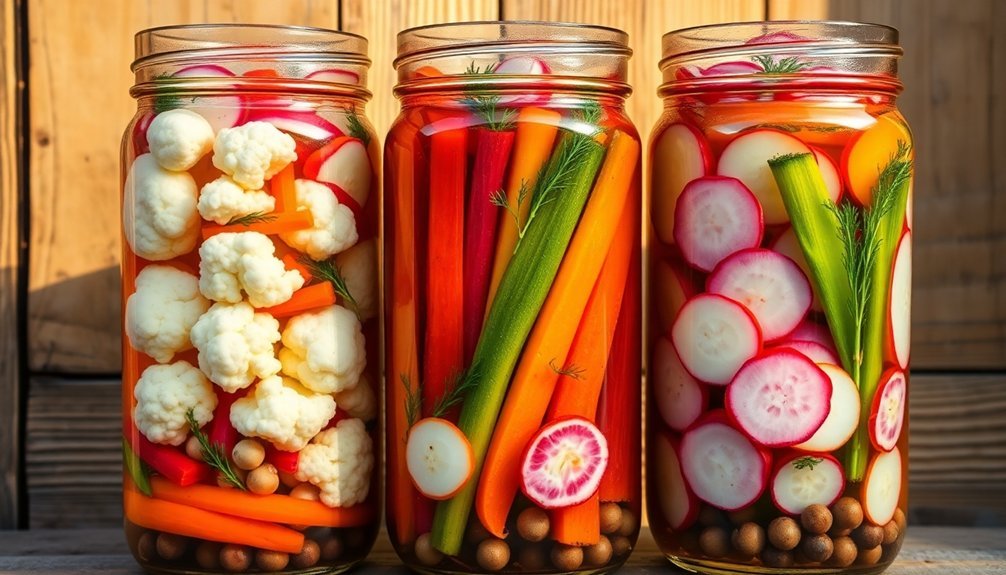
While mastering pickle storage is important, the world of pickling extends far beyond the familiar cucumber. You'll find an exciting array of vegetables that offer unique textures and flavors perfect for vinegar pickling.
For robust flavors, try pickling beets, which provide vibrant colors and pack essential nutrients like folate and iron. Red onions deliver an intense pop of color and flavor, while jalapeños can be customized with honey, cumin seeds, or oregano to suit your taste preferences.
If you're seeking interesting textures, consider asparagus, which maintains its signature crispness and works beautifully as a burger topper. Okra offers a tangy crunch that's perfect for sandwiches, while early turnips provide a tender bite while delivering fiber and vitamin C.
Don't overlook versatile options like carrots, which you can cut into rounds or spears for deliciously crunchy pickles. Cauliflower readily absorbs flavors and works well in both spicy and mild recipes.
For added variety, try zucchini in antipasti or whole garlic cloves to add depth to your pickling projects. These alternatives not only expand your pickling repertoire but also bring unique nutritional benefits to your table.
Frequently Asked Questions
Can I Reuse Leftover Pickle Brine for a New Batch?
You can't reuse pickle brine for canning, but you'll find it's great for refrigerator pickles. Just add fresh vegetables to the leftover brine and store them in your fridge for a quick pickle.
Why Do My Homemade Pickles Turn Out Mushy Instead of Crispy?
Your pickles may turn mushy if you're using slicing cucumbers, overprocessing them, or not removing the blossom end. Try using pickling cucumbers, adding firming agents, and following proper processing times for crispier results.
Are Pickled Vegetables Safe for Pregnant Women to Eat?
You can safely eat store-bought pickled vegetables while pregnant, but avoid homemade ones due to Listeria risks. Just don't overdo it, as high sodium intake isn't good for you or your baby.
Can I Pickle Frozen Vegetables Instead of Fresh Ones?
Yes, you can pickle frozen vegetables! While some may become softer than fresh ones, they'll still retain their flavor. You don't even need to thaw them first – just add them directly to your pickling jar.
Why Do My Pickled Vegetables Float to the Top of the Jar?
Your pickles float because they've got trapped air pockets and might be less dense than the brine. You'll see less floating if you pack your jars tightly, remove air bubbles, and use fresh, firm vegetables.
In Summary
You'll find that vinegar pickling opens up endless possibilities beyond traditional cucumber pickles. Whether you're experimenting with crisp carrots, vibrant cauliflower, or zesty radishes, you've got a simple way to preserve seasonal produce while creating bold flavors. Don't forget to play with different vinegars and spice combinations. With proper storage techniques, you'll enjoy your homemade pickled vegetables throughout the year.

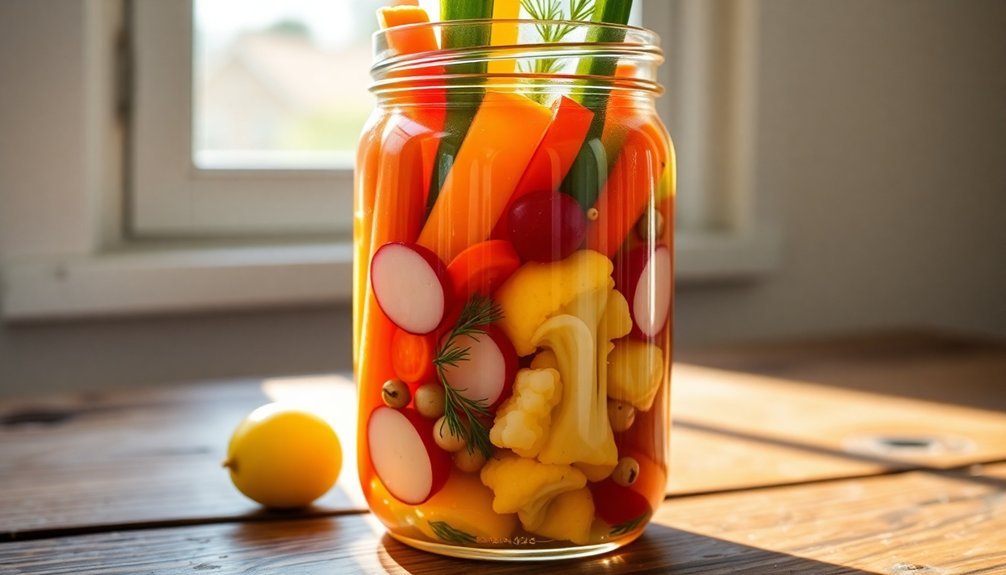



Leave a Reply